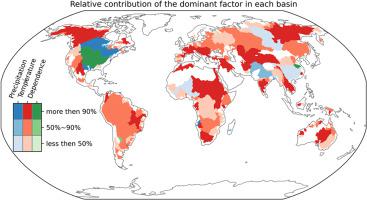当前位置:
X-MOL 学术
›
Weather Clim. Extrem.
›
论文详情
Our official English website, www.x-mol.net, welcomes your
feedback! (Note: you will need to create a separate account there.)
Compound dry and hot events over major river basins of the world from 1921 to 2020
Weather and Climate Extremes ( IF 6.1 ) Pub Date : 2024-05-09 , DOI: 10.1016/j.wace.2024.100679 Tongtiegang Zhao , Shaotang Xiong , Yu Tian , Yongyan Wu , Bo Li , Xiaohong Chen
Weather and Climate Extremes ( IF 6.1 ) Pub Date : 2024-05-09 , DOI: 10.1016/j.wace.2024.100679 Tongtiegang Zhao , Shaotang Xiong , Yu Tian , Yongyan Wu , Bo Li , Xiaohong Chen

|
Compound dry and hot events (CDHEs) are among the most destructive compound extremes. Under global warming, changes in precipitation, temperature and their dependence make profound contributions to CDHEs. In this paper, the contributions of these three factors are explicitly quantified based on a novel mathematical method. Specifically, time series of precipitation and temperature are employed to identify CDHEs and then changes of CDHEs are attributed by using the partial derivatives-based sensitivity analysis. Based on the Climatic Research Unit Time-Series (CRU TS), a case study of CDHEs is devised for the major river basins (MRBs) of the world. The results highlight that from the period 1921–1970 to the period 1971–2020, CDHEs did occur more frequently across most MRBs. The temperature tended to make the largest contribution, followed by precipitation and the dependence between precipitation and temperature. In Africa, South America and Western Europe, the rising temperature is generally the dominant factor for increases of heatwaves that contribute to CDHEs. In Asia, increases of droughts along with increases of heatwaves raise the risk of CDHEs. For MRBs with moderate increases in temperature, increasing precipitation is shown to mitigate or even offset the risks of CDHEs. In the meantime, the increasing dependence is observed to reduce the frequency of CDHEs in the Huai He and the Mississippi even though temperature is increasing. Overall, the attributing results of CDHEs from 1921 to 2020 can serve as a reference for the preparation and mitigation of CDHEs for MRBs across the world.
中文翻译:

1921—2020年世界主要流域复合干热事件
复合干热事件(CDHE)是最具破坏性的复合极端事件之一。在全球变暖的情况下,降水、温度的变化及其依赖性对 CDHE 做出了深远的贡献。在本文中,基于一种新颖的数学方法明确量化了这三个因素的贡献。具体来说,利用降水和温度的时间序列来识别CDHE,然后使用基于偏导数的敏感性分析来归因CDHE的变化。基于气候研究单位时间序列 (CRU TS),针对世界主要河流流域 (MRB) 设计了 CDHE 案例研究。结果强调,从 1921-1970 年到 1971-2020 年,CDHE 在大多数 MRB 中确实发生得更频繁。温度的贡献最大,其次是降水以及降水与温度之间的依赖性。在非洲、南美洲和西欧,气温上升通常是导致 CDHE 的热浪增加的主要因素。在亚洲,干旱的加剧以及热浪的加剧增加了 CDHE 的风险。对于温度适度升高的 MRB,增加降水量可以减轻甚至抵消 CDHE 的风险。与此同时,尽管气温不断升高,淮河和密西西比河的 CDHE 频率却随着依赖性的增加而降低。总体而言,1921年至2020年CDHE的归因结果可以为全球MRB的CDHE准备和缓解提供参考。
更新日期:2024-05-09
中文翻译:

1921—2020年世界主要流域复合干热事件
复合干热事件(CDHE)是最具破坏性的复合极端事件之一。在全球变暖的情况下,降水、温度的变化及其依赖性对 CDHE 做出了深远的贡献。在本文中,基于一种新颖的数学方法明确量化了这三个因素的贡献。具体来说,利用降水和温度的时间序列来识别CDHE,然后使用基于偏导数的敏感性分析来归因CDHE的变化。基于气候研究单位时间序列 (CRU TS),针对世界主要河流流域 (MRB) 设计了 CDHE 案例研究。结果强调,从 1921-1970 年到 1971-2020 年,CDHE 在大多数 MRB 中确实发生得更频繁。温度的贡献最大,其次是降水以及降水与温度之间的依赖性。在非洲、南美洲和西欧,气温上升通常是导致 CDHE 的热浪增加的主要因素。在亚洲,干旱的加剧以及热浪的加剧增加了 CDHE 的风险。对于温度适度升高的 MRB,增加降水量可以减轻甚至抵消 CDHE 的风险。与此同时,尽管气温不断升高,淮河和密西西比河的 CDHE 频率却随着依赖性的增加而降低。总体而言,1921年至2020年CDHE的归因结果可以为全球MRB的CDHE准备和缓解提供参考。































 京公网安备 11010802027423号
京公网安备 11010802027423号